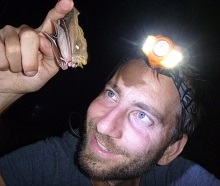Research interests
- Wildlife disease ecology
- Neotropical bat communities
- Microbial community ecology
- Habitat fragmentation

Scientific projects
Viruses and other microbes are ubiquitous natural elements of all ecosystems. As changes to the environment may affect their host organisms this may ultimately also have consequences on diversity and abundance of the associated viruses and microorganisms. Consequently, for my PhD project, I am focusing on how anthropogenic landscape modifications influence bat diversity in the tropics, and how these changes may drive virus prevalence and microbial diversity and abundance. In this context, bats are increasingly being recognized as important natural reservoir hosts for a number of viral pathogens that can result in the emergence of diseases that potentially may affect also humans.
My PhD project is part of a larger collaborative project investigating the biology of host organisms and the associated viruses, in tight cooperation between ecologists and virologists (DFG SPP 1596). The central hypothesis of our project focuses on the so-called “dilution effect”, examining the effects of habitat fragmentation and land use on diversity of rodent and bat communities and in consequence on the respective parasite/pathogen prevalence. Within this framework I focus on the bat part, relating local species diversity with the respective virus prevalence, and addressing animal health by assessing the diversity of the intestinal microbiome of common Neotropical frugivorous bats based on next generation sequencing of 16s rRNA of gut bacteria. For sampling bats I conducted a standardized mist netting approach over more than two years in different habitats around the Barro Colorado field station of the Smithsonian Tropical Research Institute in Panama. The area hosts extremely diverse bat assemblages, with more than half of the species richness represented by the Neotropical Leaf-nosed bats (Phyllostomidae). Such assemblages often experience drastic changes in response to habitat alterations, resulting in the loss of some bat species highly specialized to the original habitats, while more adaptable species may persist and even benefit from modified environments.
Already during my diploma thesis I started learning about the impact of microbiome by studying the oral microbiome of frugivorous bats in health and disease. We were targeting the question “Why do frugivorous bats not suffer from dental caries?” I was interested whether bats show a special microbiome to a sugar rich nutrition. As dental caries is a consequence of a change in the microbial community and not of a single bacterial agent, studying the oral microbiome gives first insights into this interesting question.
Publications
Qurkhuli T, Schwensow N, Brändel SD, Tschapka M, Sommer S (2019) Can extreme MHC class I diversity be a feature of a wide geographic range? The example of Seba’s short-tailed bat (Carollia perspicillata). Immunogenetics, 71, 575. doi.org/10.1007/s00251-019-01128-7
Halczok TK, Braendel SD, Flores V, Puechmaille SJ, Tschapka M, Page RA, Kerth G (2018) Male biased dispersal and the potential impact of human induced habitat modifications on the Neotropical bat Trachops cirrhosus. Ecology and Evolution, DOI: 10.1002/ece3.4161
Moreno-Brush M, Portillo A, Braendel SD, Storch I, Tschapka M, Biester H (2018) Mercury concentrations in bats (Chiroptera) from a gold mining area in the Peruvian Amazon. Ecotoxicology, 27, 45 – 54
Rose A, Brändel SD, Cvecko P, Engler S, Hiller T, Knörnschild M, Tschapka M (2017) New records of hypopigmentation in two neotropical phyllostomid bat species with different roosting habits (Uroderma bilobatum, Glossophaga soricina). Mammalia, DOI 10.1515/mammalia-2016-0086 (online first)
Conference contributions
Brändel S., Corman V., Hiller T., Rasche A., Page R., Drosten C., Tschapka M. Host-specific traits as drivers of astrovirus infections in common Neotropical bats resilient to habitat alteration. Annual Conference of the Society for Tropical Ecology, 2016, Göttingen, Deutschland
Brändel S., Wagner I., Bengelsdorf F., Mack A., Diebolder R., Stegmann B.,Tschapka M., Haller B., Hibst R., Dürre P., Kalko E.K.V (2013) Bats without Bad Teeth – Low Percentage of Dental Caries in the Neotropical Frugivorous Bat Artibeus jamaicensis. International Bat Research Conference, 2013, San José, Costa Rica
Brändel S., Wagner I., Bengelsdorf F., Mack A., Diebolder R., Stegmann B.,Tschapka M., Haller B., Hibst R., Dürre P., Kalko E.K.V (2013) Bats without bad teeth – low percentage of dental caries in the Neotropical frugivorous bat A. jamaicensis. 50th Anniversary Meeting: Association for Tropical Biology and Conservation (ATBC) & Organization for Tropical Studies (OTS), 2013, San José, Costa Rica
Brändel S., Wagner I., Bengelsdorf F., Mack A., Diebolder R., Stegmann B., Seibold G.M., Schiel-Bengelsdorf B., Tschapka M., Haller B., Hibst R., Kalko E.K.V., and Dürre P. (2013) Sweet tooth without cavities – almost no dental caries in a neotropical frugivorous bat. Treffen der Fledermausforscher in Deutschland 2013, Rottenburg-Ergenzingen
Brändel S., Wagner I., Mack A., Diebolder R., Bengelsdorf F., Schiel-Bengelsdorf B., Stegmann B., Seibold G.M., Tschapka M., Haller B., Hibst R., Kalko E.K.V., and Dürre P. (2012) Sweet tooth with good teeth – low percentage of dental caries in a neotropical frugivorous bat. Annual Conference of the Society for Tropical Ecology 2012, Erlangen (MERIAN AWARD-Gewinner)
Brändel S., Bengelsdorf F., Wagner I., Mack A., Diebolder R., Stegmann B., Seibold G.M., Schiel-Bengelsdorf B., Tschapka M., Haller B., Hibst R., Kalko E.K.V., and Dürre P. (2012) Sweet toothed bats without cavities – almost no appearance of dental caries in the frugivorous bat Artibeus jamaicensis. VAAM-Jahrestagung 2012, Tübingen
Contact
- Stefan Brändel
Institute of Evolutionary Ecology
and Conservation Genomics
University of Ulm
Albert-Einstein-Allee 11
89081 Ulm
Germany
Tel: +49 (0)731 50 22675
Email: stefan.braendel()uni-ulm.de
